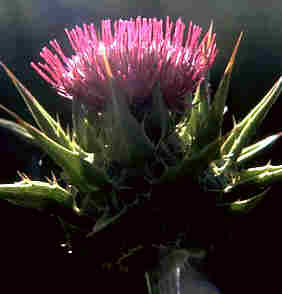
Plant Description
Caution & Interaction

Latin (botanical) name:
Silybum marianum
Common names: Holy Thistle, Marythistle, St. Mary's Thistle, Marian Thistle
Plant Description: Milk Thistle (Silybum marianum) is generally found in dry, rocky soils in southern and western Europe and is commonly seen in California. It is a stout, annual or biennial plant which can reach heights of 6 feet. It has a shiny brown stem, 1-3 feet high, with several branches and prickly thorns. Milk Thistle bears large, alternate, dark green, glossy leaves with spiny, scalloped edges and milkwhite veins. The blooms are small, composite, spherical, colorful purple-pink and pompom-like. They bloom from June to August.
Medicinal Properties &Uses: Milk Thistle contains cholagogue which stimulates the flow of bile, and galactagogue. It also contains the flavanoid silymarin which has antioxidant capabilities, and has shown a direct effect on liver cells. The active chemical component in the herb is silybin, which functions as an antioxidant and is one of the most potent liver protective agents known. Clinical trials have proven silybin to be effective in treating chronic liver diseases and in protecting the liver from toxic chemicals. As such, Milk Thistle is an excellent tonic for the liver and helps protect it from degeneration, and is actually capable of repairing damaged cells. Because of the bile-producing cholagogue, fats are broken down, thereby protecting the liver against toxic damage from nicotine, drugs, alcohol, and environmental toxins such as carbon monoxide. Additionally, Milk Thistle helps to lower elevated liver enzymes and help prevent cirrhosis and necrotic liver damage. It can be used long-term with no adverse effects as it is non-toxic. It is especially effective in protecting the liver and assisting it in detoxing from the results of chemotherapy. This herb is an excellent tool in combating hepatitis and inflammation of the liver. Milk Thistle is recommended for all smokers or anyone exposed to secondhand smoke and other pollutants. It is also a stimulant, a demulcent, and an antidepressant, and has anti-inflammatory properties. As such, it is supportive to many therapies for patients with autoimmune disorders, rheumatoid, swollen prostate, asthma, psoriasis, and eczema. Additionally, an injection of Milk Thistle's active component silybin is a proven antidote for poisoning with the Deathcap mushroom (Amanita phalloides).
Dosage: 30-60 drops in water or juice, 2-3 times daily or as needed.
Cautions & Interactions: Keep out of reach of children.
Efficacy Studies & Other Clinical Data:
Disclaimer (U.S. Only): These statements have not been evaluated by the FDA. These products are not intended to diagnose, cure, treat, or prevent any disease.
Common names: Holy Thistle, Marythistle, St. Mary's Thistle, Marian Thistle
Plant Description: Milk Thistle (Silybum marianum) is generally found in dry, rocky soils in southern and western Europe and is commonly seen in California. It is a stout, annual or biennial plant which can reach heights of 6 feet. It has a shiny brown stem, 1-3 feet high, with several branches and prickly thorns. Milk Thistle bears large, alternate, dark green, glossy leaves with spiny, scalloped edges and milkwhite veins. The blooms are small, composite, spherical, colorful purple-pink and pompom-like. They bloom from June to August.
Medicinal Properties &Uses: Milk Thistle contains cholagogue which stimulates the flow of bile, and galactagogue. It also contains the flavanoid silymarin which has antioxidant capabilities, and has shown a direct effect on liver cells. The active chemical component in the herb is silybin, which functions as an antioxidant and is one of the most potent liver protective agents known. Clinical trials have proven silybin to be effective in treating chronic liver diseases and in protecting the liver from toxic chemicals. As such, Milk Thistle is an excellent tonic for the liver and helps protect it from degeneration, and is actually capable of repairing damaged cells. Because of the bile-producing cholagogue, fats are broken down, thereby protecting the liver against toxic damage from nicotine, drugs, alcohol, and environmental toxins such as carbon monoxide. Additionally, Milk Thistle helps to lower elevated liver enzymes and help prevent cirrhosis and necrotic liver damage. It can be used long-term with no adverse effects as it is non-toxic. It is especially effective in protecting the liver and assisting it in detoxing from the results of chemotherapy. This herb is an excellent tool in combating hepatitis and inflammation of the liver. Milk Thistle is recommended for all smokers or anyone exposed to secondhand smoke and other pollutants. It is also a stimulant, a demulcent, and an antidepressant, and has anti-inflammatory properties. As such, it is supportive to many therapies for patients with autoimmune disorders, rheumatoid, swollen prostate, asthma, psoriasis, and eczema. Additionally, an injection of Milk Thistle's active component silybin is a proven antidote for poisoning with the Deathcap mushroom (Amanita phalloides).
Dosage: 30-60 drops in water or juice, 2-3 times daily or as needed.
Cautions & Interactions: Keep out of reach of children.
Efficacy Studies & Other Clinical Data:
-
Milk Thistle: Effects on Liver Disease and Cirrhosis
and Clinical Adverse Effects
-
Clinical Studies - Milk Thistle
Disclaimer (U.S. Only): These statements have not been evaluated by the FDA. These products are not intended to diagnose, cure, treat, or prevent any disease.